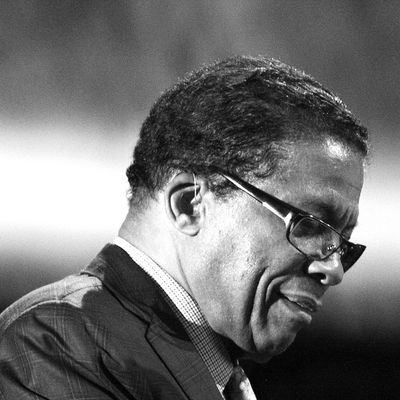
Jazz icon Herbie Hancock has had a long, trailblazing career, from his classic work with Miles Davis in the ÔÇÿ60s through his wildly popular funk and hip-hop excursions in the ÔÇÿ70s and ÔÇÿ80s, and into his current guise as one of the genreÔÇÖs preeminent experimenters and popularizers. But despite a habit of musical mold-breaking,┬áthe keyboardist has fallen prey to some all-too-common show-business demons. In this excerpt from his memoir, Herbie Hancock:┬áPossibilities (Viking),┬áout October 23, Hancock, 74,┬áshares his first experience with the drug, crack, that would take him years to overcome.
One night I drove to a friendÔÇÖs place in Beverly Hills for a birthday party, and as I was parking I saw two women I knew getting into their cars. ÔÇ£Are you leaving?ÔÇØ I asked.
ÔÇ£Yeah,ÔÇØ one of them said. ÔÇ£You might not want to go up there.ÔÇØ Before I could ask what she meant, the car started up and they were gone.
I decided to head in and see what was happening. When I walked into the apartment, I didnÔÇÖt see my friend and didnÔÇÖt know most of the people there. They were mostly standing around, talking and drinking, but there was also cocaine on the coffee table. I got myself a drink, and after a while I noticed that people were coming in and out of one of the bedrooms. It seemed like they were trying to hide whatever was going on back there, but when they came out of that room, I could see that they were high.
Somebody finally asked me, ÔÇ£Have you ever smoked cocaine?ÔÇØ ÔÇ£Nooo,ÔÇØ I said. ÔÇ£IÔÇÖm afraid to do anything like that.ÔÇØ For me, there was a clear line between snorting cocaine and smoking it. Crack cocaine was a relatively new drug, but to my mind it fell on the same side of the line as heroin, which I would never touch. I knew what heroin had done to musicians like Charlie Parker, Chet Baker, and John Coltrane in his early years. It wasnÔÇÖt a drug you could take recreationally; it was a drug that took over your life, and that was my impression of crack, too.
As the party went on, though, I found myself getting more and more curious. What is this thing that people are talking about thatÔÇÖs so bad? Crack was a cocaine derivative, and I didnÔÇÖt have a problem with cocaine. What was so different about this drug? ┬áAfter a while I couldnÔÇÖt contain my curiosity. ÔÇ£Hey, I changed my mind,ÔÇØ I said. ÔÇ£I want to try it.ÔÇØ
My friend asked, ÔÇ£Herbie, are you sure you want to do this? It may not be a good idea.ÔÇØ Then someone else standing nearby said, ┬áÔÇ£ItÔÇÖs all right! Let him try it.ÔÇØ
I said, ÔÇ£I want to see.ÔÇØ So I was led down the hallway into the bedroom, where somebody put a pipe in my mouth and lit it. ÔÇ£Draw it in and hold it,ÔÇØ the person told me. I did. And when the high hit me, it was like nothing IÔÇÖd ever felt. Crack overloads the pleasure center of your brain, hitting you with a wave of every pleasurable sensation you can imagine, physical and emotional, all at once. I closed my eyes and thought, Oh, shit. I should never have done this. This stuff was obviously way too dangerous to mess with.
I decided that night that this would be the last time I ever smoked crack. Unfortunately that resolution lasted only about a month before I picked up the pipe again.
For a while I managed to smoke only once every couple of months or so, and every time I did, I swore it would ┬ábe the last. I made rules for myself: IÔÇÖd never do it on tour, or when my family was around. And I never told Gigi ÔÇö never told anybody, in fact, except the very few people I actually smoked with. I was super paranoid about being found out and having my career, and maybe my life, ruined.
But I just could not stop doing it, even though months would go by between sessions. I was sure IÔÇÖd be able to quit at some point, but I had no idea how far in the future that might be. In the meantime, I guarded my secret and tried to keep things under control. As time went on, that would become more difficult to do.
From HERBIE HANCOCK: Possibilities by Herbie Hancock with Lisa Dickey. Reprinted by arrangement with Viking, a member of Penguin Group (USA) LLC, A Penguin Random House Company. ┬áCopyright ┬® Herbie Hancock, 2014.

